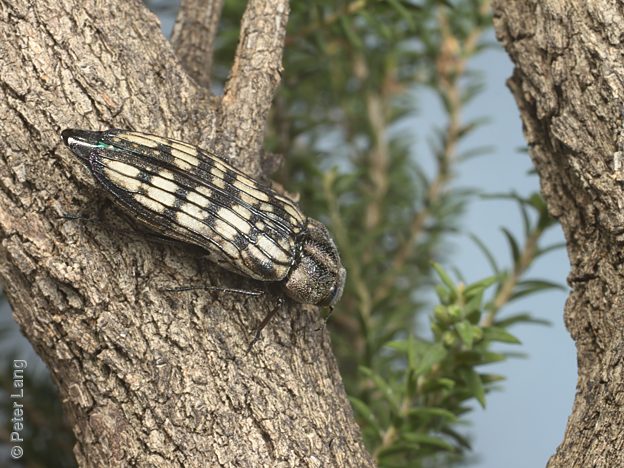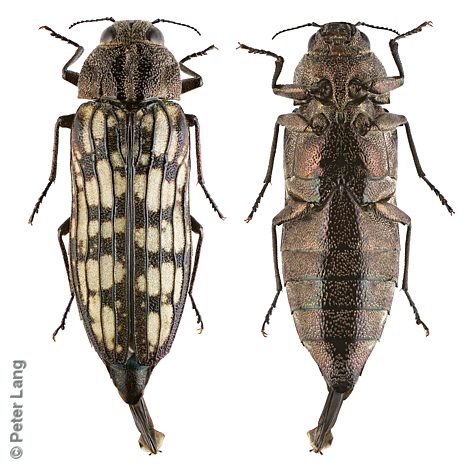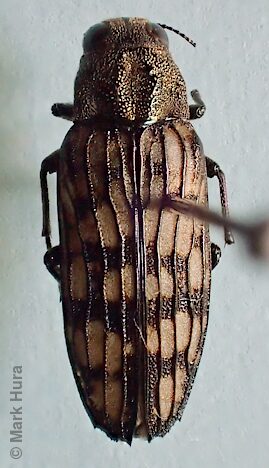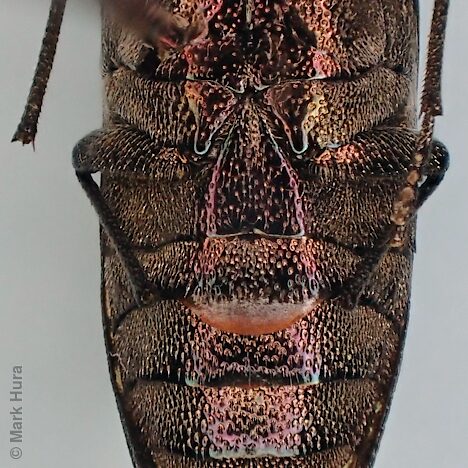



size¹:
×
7.0 mm




| female | ||||||
|---|---|---|---|---|---|---|
| L1 | 19.2 | n = 1 | ||||
| L2 | 18.8 | n = 1 | ||||
| W | 7.0 | n = 1 | ||||
| Legend | L1 | length from clypeus/frons to elytral apex (mean, range, sample size) |
| L2 | length from anterior of edge of eyes to elytral apex | |
| W | maximum width with elytra fully closed |
Distinctive elytra with a pale straw-coloured background, blackish ribs and marbled dark brown patches; pronotum with a median longitudinal depression and raised longitudinal thickenings on either side.
This species was known as Neobuprestis marmorata before it was transferred by Levey & Bellamy 2013 to their new genus Burnsiellus. They specifically state that the name, which commemorates the late Gordon Burns' contributions to 'buprestology', is a masculine generic name. The species epithet needs to match it in gender so Burnsiellus marmorata becomes B. marmoratus according to Article 31.2 of The International Code of Zoological Nomenclature.
My treatment here of Burnsiellus marmoratus includes Burnsiellus lobatus as a synonym. Levey & Bellamy 2013 described "Burnsiella lobata" as a new species and nominated, as the most important difference, the large semitransparent median extension or lobe on the posterior margin of the second visible abdominal ventrite. They even suggested that this feature might justify placing the species in a separate subgenus or genus. However, they refrained from doing so in the absence of a female specimen. This was on the grounds that it might be a secondary sexual characteristic of the male and thus an unsuitable basis for a generic distinction.
However this feature is also evident in specimens that otherwise match B. marmoratus and appears to be an unsuitable basis for a species distinction also - see the last two images above of a specimen from the MU region which was collected and photographed by Mark Hura.
Significantly, Levey & Bellamy 2013 only cite female and unsexed material of B. marmoratus as having been examined by them and so would have missed seeing this secondary sexual male characteristic on 'normal' specimens of the species. Also, they based their description of B. lobatus on a single old male holotype specimen collected prior to 1853 which was darkly coloured. They interpreted this as cryptic colouration, possibly related to crepuscular or nocturnal behaviour. I consider that it most likely to be a consequence of the aging of that specimen. In the pattern of raised sculpturing on the pronotum and elytra, and distribution of darker areas on the latter, it is a close match to B. marmoratus.
| Legend | P.J.Lang collection vouchered records | |
| other private collection or museum specimens, or sightings |
|
|
|
|
|
|
|
|
|
|
|
|
|
||||||||||||||||||||||||||||||||||||||||||||||||
|
|
|
|
|
|
|
|
|
|
|
|
|
||||||||||||||||||||||||||||||||||||||||||||||||
| Jul | Aug | Sep | Oct | Nov | Dec | Jan | Feb | Mar | Apr | May | Jun |
| Legend | live emerged adults, count > median value of 1 per quarter month | |
| live emerged adults, count <= median value of 1 | ||
| live non-emerged adults only, for that quarter month | ||
12 | number of active beetles for that quarter month |
Levey & Bellamy 2013 report breeding records for B. marmoratus in WA, discovered by Paul Hutchinson and Mike Powell in trunks and branches of Dryland Tea-tree Melaleuca lanceolata, which is a very common species in SA.
| ¹ Legend | regions | SA State Herbarium regions (map) EA: Eastern, EP: Eyre Peninsula, FR: Flinders Ranges, GT: Gairdner-Torrens, KI: Kangaroo Island, LE: Lake Eyre, MU: Murray, NL: Northern Lofty, NU: Nullarbor, NW: North-Western, SE: South-Eastern, SL: Southern Lofty, YP: Yorke Peninsula |
| size | The ellipse is the correct size when printed, indicative on a desktop screen, and likely to be wrong on a mobile device. |